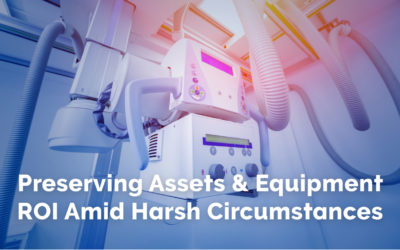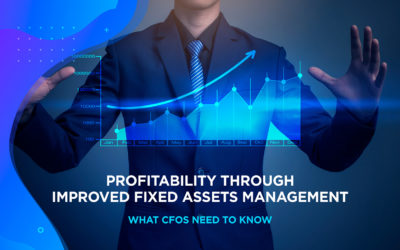The enterprise asset management industry has been experiencing positive momentum of late. With the industry projected to be valued at $8.8 billion by 2024, today’s leading enterprises must leverage Computer Maintenance Management Software (CMMS) technology to transform maintenance and inventory management. The use of CMMS maintenance management improves on traditional maintenance and inventory management models.
In an increasingly competitive marketplace, embracing next-generation technology solutions and trends accelerates transformation and enables organizations to differentiate themselves from the myriad of competitors. This creates a more agile organization, streamlines core operations, and reduces cost while increasing throughput.
The landscape of asset management is evolving. The following are five trends that are expected to dominate and transform the asset management industry for years to come.
1. Proactive maintenance practices
Unplanned outages, including those caused by pandemics and other global crises, can threaten an industrial facility’s ability to properly maintain assets. Downtime associated with unplanned outages can be extremely costly, resulting in production shortfalls and increased labor costs.
Equipment failure can also lead to safety hazards or dangerous breakdowns. This can cause a rise in potential dangers associated with unplanned outages. In the event of a serious breakdown, employees and company resources can be at significant risk.
Proactive management of industrial maintenance will continue to make its case against traditional, passive maintenance solutions. A proactive approach anticipates and resolves underlying maintenance problems before they can occur.
This is of vital importance as it ensures all equipment runs at peak performance levels, lowering maintenance and labor costs as well as dramatically reducing unplanned outages.
*Downtime associated with unplanned outages can be extremely costly, resulting in production shortfalls and increased labor costs. Unexpected, rapid shifts such as the Covid pandemic have also highlighted how crucial it is to uphold a future-ready, proactive approach to managing systems and facilities.
2. Going mobile
Innovative CMMS software is complemented by mobile features that help industrial facilities streamline maintenance and asset management processes. With a corresponding mobile app integrated into CMMS software, facilities managers are able to make maintenance assessments on the go.
Maintenance managers can use mobile asset management software to implement new work orders, check repair histories, audit trails, and even access parts catalogs to place purchase orders. As many asset management tasks can be done on the mobile platform, maintenance managers can make data-driven decisions from anywhere at any time.
3. The democratization of information
Improved access to maintenance resources enables facilities managers to share effective maintenance management practices and standardized operational procedures. Standardization of data provides greater asset and inventory visibility.
Greater visibility changes the culture of the maintenance department, allowing managers to implement a standardized proactive maintenance plan. This collaborative approach empowers technicians, synchronizing maintenance work tasks so optimal uptime and operational performance are achieved.
This trend towards enforcement of standard operating procedures eliminates duplicate maintenance processes which lead to greater improvements in labor efficiency and reduction of operational costs.
4. Asset accountability
As CMMS software delivers unprecedented transparency, facility managers can better monitor their maintenance operations. This allows them to quickly identify and determine what tasks have been completed and what still needs to be done.
Further, greater visualization of asset management results in a better understanding of an asset’s life cycle. Full asset details can be viewed, extending the longevity of all assets while minimizing the effort associated with maintenance tasks and outputs.
A move towards greater transparency allows industrial facilities to experience greater accountability. Improved accountability facilitates a more effective use of resources, from labor to inventory, which allows the asset management software to deliver excellent business value.
5. Unlocking the value of 5G
Over the next three to five years, 5G is expected to be one of the most disruptive technologies to hit the market, becoming the linchpin of a new data-driven ecosystem across numerous vertical sectors like manufacturing, oil and gas, healthcare, and education.
The possibilities of 5G will allow for machine-enhanced decision-making, data-rich environments, agile automation, intelligent efficiency, and trusted connections. These improvements in the industrial complex will dramatically improve productivity, safety, and efficiency.
As 5G is capable of connecting everyone to everything and everywhere, industrial facilities and other vertical sectors that use CMMS and enterprise asset management software can expect to derive value from this new connected ecosystem.
Within these vertical sectors, 5G technology improves responsiveness to increase maintenance and asset management efficiencies. This has an overall impact on revenue figures and can serve as a pivotal driver for business growth.
The enhanced connectivity of 5G will improve output and ensure proactive maintenance measures are supported by emerging technologies like the Internet of Things (IoT) and data analytics. This allows vertical sectors to gather smart data insights that inform decision-making.
These emerging technologies will be pivotal elements in accelerating innovation and provide organizations with unique competitive advantages to compete in the future.
Digital-enabled disruptions
As enterprise asset management becomes more digital-centric, upcoming trends such as new technology enablement, asset transparency and accountability, and more proactive maintenance practices will compel more organizations to adopt maintenance control software like CMMS or EAM.
More innovative and robust asset management systems enable vertical sectors to be more efficient and realize optimum asset life cycles while improving inventory management practices.
In today’s hyper-competitive market, the implementation of these disruptive trends enables organizations to leverage digital asset management solutions that ensure they stay ahead of the curve. Aladdin has everything you need to keep your business going strong, in booming times, and even during periods of uncertainty. Contact us today for a demonstration of our cloud-based software system and see how it can help streamline your asset management and maintenance processes.




0 Comments